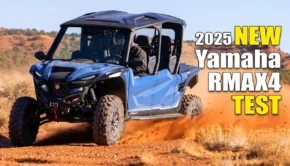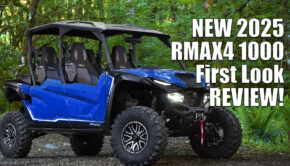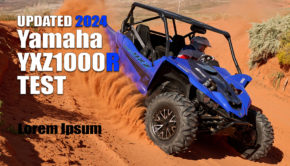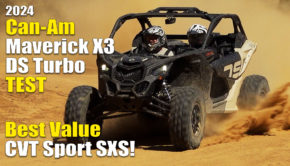Published on September 9th, 2020 | by Joe
2021 Yamaha Wolverine RMAX2 and RMAX4 1000 First Look
Yamaha RMAX 1000 takes aim at the Polaris General XP 1000!
On Sept. the 3rd 2020, Yamaha revealed the details on their brand new two and four-seat Wolverine RMAX sport/utility SXS models.
The all new Wolverine RMAX’s come well appointed with an impressive spec sheet which seems to blur the lines even further between the sport and sport/utility segments.
According to Yamaha the 1000cc class is far and above the largest in the sport/utility segment among trail riders and explorers, and it’s a class they’ve been absent from until now.
With specifications that far exceed most of the current 1000cc class competitors, the new Wolverine RMAX appear poised to give the Polaris General XP 1000 a tough battle for the 1000cc sport/utility crown while potentially capturing more of the naturally aspirated sport segment from drivers wishing for a CVT equipped, 64” wide machine from a Japanese manufacturer.
Engine
AT the heart of the new RMAX is a brand new 999cc, liquid-cooled, parallel twin-cylinder engine featuring 4 valves and double overhead cams per cylinder. Yamaha recommends premium pump gas with the engine’s 11.2:1 compression ratio which is higher than some sport class machines. The engine is said to produce 108hp, with class leading horsepower and torque, propelling the machine to a top speed just under 70mph with an 8,500 rpm redline.
The parallel twin has a 270° firing order for increased torque and traction due to the closer firing order with more space between power surges. Yamaha is claiming a 4% reduction in rotating mass compared to the 850cc class Wolverine X2/X4 models and less mass typically means improved rev-ability. A counter balancer and 4-point rubber engine mounts were employed to keep vibration to a minimum.
Oil is circulated via dry-sump lubrication with an oil cooler for added cooling. A shallow sump profile on the bottom of the engine and an inclined engine layout, allow for a more compact design with a lower center of gravity.
As we would expect on a high-performance engine, the latest surface treatments were used on the engine internals. Air for the engine and CVT are mounted high, with the engine’s intake providing tool-free access to a primary foam filter. There’s also a secondary paper filter that Yamaha claims will not pass dirt. Fuel is delivered via Yamaha Fuel Injection with dual, 48mm throttle bodies.
As with other Yamaha Ultramatic, fully-automatic CVT transmission equipped machines, Yamaha is covering the RMAX’ CVT drive belts with a 10-year belt warranty. A primary wet clutch eliminates the need to slip the drive belt on take-offs greatly reducing wear. Although, this type of transmission is a bit harder to tune with aftermarket clutch kits. Exhaust from the CVT is utilized to cool the exhaust pipe and spark plug coils. A transmission with internal gears specifically designed for smoothness combined with single inline front and rear driveshafts, help keep the drivetrain running smooth and quiet. With the capability of 2wd, 4wd, and 4wd with front differential lock, Yamaha’s On-Command drive system has always worked flawlessly for us.
Available on XT-R and LE models, for the first time, Yamaha is offering multiple drive modes on a SXS with their Yamaha Chip Controlled Throttle offering sport, trail, and crawl modes. Each mode is designed to offer maximum throttle with sport mode tuned for quick acceleration and responsiveness to throttle input. Trail mode is tuned for smoother acceleration and more linear response with crawl mode offering slower response for greater traction in rocks or mud. Drive modes also effect engine braking. Trail and crawl modes offer full engine braking with sport mode tuned for smoother engine braking, preferable when coming down from speed in whooped out or choppy terrain.
Yamaha’s intelligent speed management system is engaged by a removable key under the hood that limits the machine to a top speed of 25mph while still allowing full engine power for steep climbs or towing heavy loads without any drawbacks in power delivery. Apparently only those affluent enough to spring for the LE model are able to enjoy this feature. So if you aren’t one of the lucky ones, don’t loan your RMAX to drivers you don’t trust.
Chassis and Suspension
The RMAX models are built on brand new steel frames sharing a 64” width, ideal for adapting well to all types of terrain. Most of the underside of the frame is covered by a welded on steel skid plate with a front plastic skid plate and rear CV guards. Kickouts on the lower frame rails help pretend snagging rear wheels on trees of other obstacles. Winch ready steel bumpers come standard on all models with tie down hooks for easier trailering and integration for two accessory lights. XT-R and LE models front bumpers benefit from plastic covers and integration for four accessory lights. They also come equipped with Warn winches.
Both RMAX utilize dual A-Arms front with wide-arc lower arms for improved ground clearance. Dual control arms out back utilize single stamped designed lower arms for improved strength.
Fox Podium 2.0 QS3 shocks are used on the standard and XT-R models with Fox IQS shocks used on the E model. Both shocks feature nitrogen reservoirs, dual rate springs with preload adjustment, and three-way compression damping adjustability with comfort, medium, and firm settings for different speeds and terrains. The QS3 shocks have three position dials on the shocks reservoirs while the IQS system allows you to select between the different settings via a switch inside the cockpit. Performance enthusiasts like us might bock at the simplicity of three-position compression damping adjustment, but it’s been proven to work pretty well on other models and its simplicity helps take the guess work out of getting the ride you’re looking for, if Yamaha and Fox nailed the spring rate and valving. According to Yamaha the shocks were optimized for maximum low-speed comfort and maximum articulation while still offering a high-level of bottoming resistance.
The RMAX2 features class-leading suspension travel at both ends with 14.2” front and 16.9” rear. That’s nearly 3” more rear suspension travel then General XP 1000, within 1/10” of an inch of Yamaha’s YXZ1000R sport SXS, and more overall travel than the 64” wide Honda Talon X sport machine. While both machine’s use front sway bars, the RMAX2 foregoes a rear sway bar for maximum articulation. Yamaha felt rear seat passengers on the RMAX4 would benefit from continuing to use one.
The RMAX2’s 86.7” wheelbase is claimed to improve the contact to ground feeling on steep climbs and descants compared to the 83” wheelbase of the General XP 1000. Rolling on 30X10-14” radial tires on 14” aluminum wheels the RMAX2 delivers the square wheel tire setup we prefer with GBC Dirt Commander 2.0 tires used on the standard model and Maxxis Carnivore tires used on the XT-R and LEs. Ground clearance is class leading at 13.8”
With 14.2” of suspension travel front and 13.3” of travel out back, the RMAX4 is just shy of the overall travel of the General XP 4 1000. The RMAX4 features a 90.2” wheelbase, around 24” shorter than the General XP 4 and within 3/10” of the wheelbase of Yamaha’s two-seat, sport, YXZ1000R, leading us to think that the RMAX4 should handle like a two-seater on tight trails. They opted to go with a staggered radial tire setup with 29×9-14” tires up front and 29×11-14” tires rear for more precise steering with the four-seat configuration, and a reduced tire sidewall height for reduced tire roll.
This makes sense on a vehicle that will be loaded down with four occupants. Like the RMAX2, Dirt Commander tires are used on the standard model, with Carnivores on the LE and XT-R editions. Its 13.4” of ground clearance are within 1/10” of the General XP but its shorter wheelbase could certainly give it the advantage in tighter trails.
No other manufacturer has sorted out power steering quite as well as Yamaha. Its light, natural feeling with a good amount of feedback from the trail, while eliminating jarring impacts from being transferred back through the steering wheel. Optimized for use with 29-30” tires Yamaha is now offering a 2nd selectable mode to make steering easier when the front differential is engaged which could prove to be a significant upgrade depending on its effectiveness.
With Yamaha claiming wet weights with all fluids installed and Polaris listing dry weights it’s harder to speculate on power to weight ratios. Yamaha’s wet weight of 1884.9 lbs. compares to Polaris’ dry weight of 1,712 for the General XP. The RMAX4’s claimed wet weight is 2,059.1 lbs, compared to Polaris’ wet weight of 2,058 lbs for the General XP 4. Hard telling how they’ll finish on the drag strip but we’d say the RMAX4 could certainly be a bit lighter than the Polaris.
Brakes
The RMAX are slowed by four-wheel hydraulic disc brakes. 255mm rotors with 32mm calipers are used up front with 244.5mm rotors and 27mm calipers out back. Dual piston calipers are found at both ends. Steel braided brake lines are used for enhanced power and feel.
Work Capability
With all the promise of performance comes the capability to get work done or haul more gear out for the weekend. Both units feature a 2” hitch receiver with 1 ton of towing capacity. The RMAX2 features a cosmetically well disguised, hydraulically assisted, composite dump bed with multiple steel tie-down points and 600lb of cargo capacity. The RMAX4 foregoes the dumping cargo bed but allows the rear seats to be individually stowed forward expanding rear cargo space. It also features multiple steel tie down points and can haul up to 600lb of cargo.
Interior and Other Details
Entering and exiting the RMAX has been made easier with a 63% increase in the lower body opening with 33% more room up top. New 3-piece doors feature interior door handles located farther from flying mud. Integrated door speaker pods are designed to make installing speakers easier with improved acoustics.
A blue backlit led display is mounted just behind the steering wheel and appears easy to read. The automotive style cockpit is said to be larger for all occupants with soft touch points located throughout. The driver’s seat features nearly ½” more rearward movement compared to the previous Wolverine X2 and X4. To keep you securely in place the seats feature increased bolstering with new cut and sewn seat covers. The seat belts feature tool free, 6-point adjustability in 20mm increments.
Comfort and control were addressed with a revised brake and gas pedal, welcomed additions as we found modulating the throttle difficult at lower speeds on the 2019 Wolverine 850s. A 17° tilt adjustable steering wheel is constructed of a softer durometer rubber. The passenger benefits from a new quick adjust, T-shaped grab handle with 95mm of adjustment that can be adjusted in 4mm increments.
Interior storage includes a 5.8L passenger glove box and 2.7L center console. There are cubbies in the center console as well as driver and passenger side storage shelves. There are 2 cup holders found in the RMAX2 with 6 in the RMAX4.
XT-R and Limited edition RMAX models benefit from Yamaha Adventure Pro GPS tablet integration along with a USB charge port. The Adventure Pro can be locked in place for security and removed for use in your car or truck.
These models also come with blue interior lights, backlit switches, and rearview mirrors. LE models also benefit from an SSV Works audio system with 6.5” door speakers mounted in the integrated door pods, is prewired for a sub-woofer in the RMAX2 with additional wiring for overhead speakers in the RMAX4.
All RMAX2 models, plus XT-R and LE RMAX4 models come with sun tops standard featuring integration with Yamaha’s accessory windshield, cab enclosure system and mirrors. The RMAX4 roof features integrated speaker pods for rear occupants.
If you like to accessorize your rig like us, it’s worth noting that Yamaha already has over 100 accessories ready to go for the new Wolverine’s with most of them built in house using CAD drawings from the machines to ensure OEM quality fitment, a matching finish, an rust protection on steel parts.
When it comes to off-road vehicles it’s the performance on the inside that counts but we feel Yamaha nailed the looks of the machine. Its modern sporty styling is accented with new LED marker lights. 7.6W LED low beams with 15.2W reflector high beam headlights are found out front with LED tail and reverse lights found out back.
Conclusion
Without a test we can’t say anything definitive regarding performance, although on paper Yamaha looks like a class leader that’s capable of stealing away some of the naturally aspirated sport SXS segment.
Their specifications make all three trim levels impressive. With premium performance comes a premium price. However, with Polaris’ two-seat, entry level General XP 1000 starting at $22,999 you can get in an entry level RMAX2 for $3,200 less at $19,799. The same comparison in the four-seat segment gets you into the RMAX4 for $3,700 less at $21,299. Comparable premium packages are very similarly priced.
To get a full grip on the different packages available visit Yamahamotorsports.com.
Tell us what you think of the new Yamaha Wolverine RMAX 1000 in the comments below and make sure to let us know if you want to see a shootout between the General XP 1000 and the new Yamaha RMAX. While you’re at it make sure to subscribe so you don’t miss what’s next from UTV on Demand.









